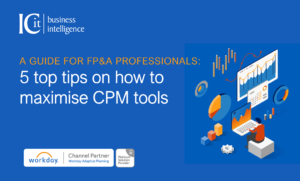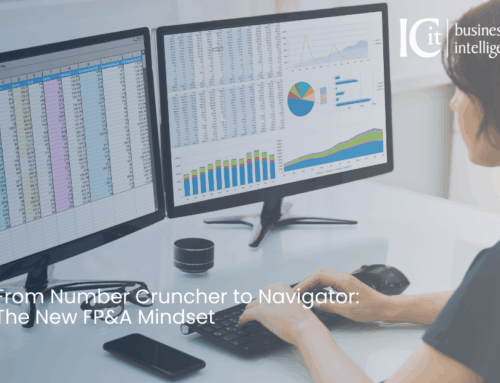Introduction
Financial Planning & Analysis (FP&A) teams are essential to the strategic and financial health of every organisation. You navigate through vast amounts of data to provide insights that drive business decisions. With Corporate Performance Management (CPM) tools, you can address common challenges in planning, forecasting, and reporting more effectively.
Our survey* of FP&A professionals clearly demonstrated that there’s still a long way to go before FP&A teams become recognised as a trusted provider of strategic insight rather than merely the number crunchers. 81% of respondents said they were stuck in low value, manual tasks and 75% said their FP&A planning cycles were too long.
This blog offers top tips to maximise the potential of CPM tools in your FP&A processes.
1. Streamline Data Integration and Management
Embrace Data Automation:
Incorporate automation to minimise manual data entry. CPM tools can seamlessly integrate with ERP systems, CRM platforms, and other data sources. This integration facilitates real-time data access, improving the accuracy of financial planning and forecasting. In our FP&A sector survey, 71% of FP&A professionals stated that their organisations still had disparate and legacy systems in place that proved cumbersome to maintain. A CPM tool can help you address this challenge.
Centralise Data Storage:
Leverage CPM to centralise data storage, providing a single source of truth. This centralisation enhances data integrity and ensures consistency across all financial reports and analyses. Not only will this consistency give you the confidence to trust the data, but it will also help you improve the level of transparency that goes beyond simply being upfront with the numbers. It’s also about presenting financial information in a way that tells the real story of what’s happening and why, and its impact on your company.
2. Enhance Forecasting with Advanced Analytics
Implement Predictive Modelling:
Utilise the predictive analytics capabilities of CPM tools to identify trends and project future performance. These models can analyse historical data and current market conditions to produce more accurate forecasts. The most successful companies have FP&A teams that can quickly model the impact of changes to plans, such as new client acquisition, changes to pricing and expansion into new markets.
Optimise Scenario Planning:
Capitalise on the scenario planning features of CPM tools to prepare for various business contingencies. By simulating different financial scenarios, you can develop strategies that are resilient to market volatility. As well as providing valuable insight, it’s also important to be able to do this quickly and produce new, what-if scenarios on-the-fly in minutes. If this process is still not optimised in your business, you’re not alone. In our FP&A survey 68% of people said their scenario planning was immature and too manual.
3. Foster Collaborative Financial Planning
Improve Interdepartmental Collaboration:
Use CPM tools to create a collaborative environment for budgeting and planning. By allowing multiple departments to contribute data and insights, FP&A teams can ensure that financial plans are comprehensive and aligned with company-wide objectives.
CPM tools provide consistency and ease of use to planning so business users can self-drive their plans, leading to trust and ownership of the business plan. This leaves you and your team free to spend time with business partners, getting under the skin of operational issues and providing advice and support, leading to stronger relationships, trust and ultimately, more accurate planning.
The built-in collaboration and workflow functionality of CPM tools can help you to streamline communication between finance and non-finance teams. This ensures that everyone is on the same page, reducing errors and increasing productivity.
Enhance Communication:
CPM platforms often include communication tools that streamline discussions around financial data. These tools can help you stay connected, share insights, and make informed decisions quickly.
By reducing manual effort and errors, you can significantly reduce production time, allowing you to spend more time understanding the story behind the numbers and providing insight led recommendations to senior stakeholders.
Also, don’t forget how quickly credibility can be eroded by presentation inconsistencies. Using an integrated presentation tool that draws from a single source of up-to-date data, reinforces your credibility and the trust your team has with its stakeholders.
4. Develop Dynamic Reporting Capabilities
Customise Dashboards:
Develop dynamic dashboards that provide real-time insights into key financial metrics. These dashboards can be customised to the needs of different stakeholders, ensuring that they always have access to relevant information. Our FP&A survey found that 80% of respondents felt that they needed to enhance data-driven decision making with more accurate, timely and relevant reports and dashboards.
Make Reporting Interactive:
Leverage the interactive reporting features of CPM tools to delve deeper into financial data. Interactive reports allow you to explore data at a granular level, enhancing the understanding of financial outcomes.
Using CPM tools can help you refresh Excel reports, Powerpoint slides and Word documents with a single-click. In addition, cloud-based reporting and dashboarding is automated and fully connected to underlying data. This means when changes occur, reports can be updated in minutes with no manual intervention. Also, there is no need to manually “roll over” monthly reports for the next period – simply refresh with the latest data.
5. Prioritise Training and User Adoption
Invest in Training:
Allocate resources for comprehensive training on CPM tools. Proper training ensures that FP&A teams can leverage all features effectively, improving productivity and strategic analysis.
In addition, when looking to recruit the best talent it’s important for you to demonstrate that the role of finance has evolved from number crunching to providing strategic insights to help your organisation make the right decisions.
You can also use CPM tools to actively manage skill requirements and knowledge gaps. You can create a plan to “build, borrow or buy”, for example, train existing resources, borrow specialist skills within the organisation, or recruit new people.
Encourage Adoption:
Promote the adoption of CPM tools across the organisation by demonstrating their value in simplifying processes and providing actionable insights. Highlight success stories and quick wins to gain buy-in from all levels of the organisation.
Moving finance teams away from an Excel-centric model into a more data-centric operation, will undoubtedly improve the perception of FP&A, increase job satisfaction and reduce attrition. It will help you embed it into you FP&A team efficiently and effectively, whilst also gaining buy-in from stakeholders across the business as they start to see the value that dynamic planning can bring to their decision making.
Conclusion
CPM tools offer FP&A professionals unparalleled support in overcoming the challenges of planning, forecasting, and reporting. By following these five tips, FP&A teams can not only streamline their financial operations, but also contribute more strategically to their organisations’ success. Embrace the technology, harness its full potential and transform your FP&A function into a powerhouse of insight and foresight.

To learn more about how to maximise CPM tools in your your FP&A processes, download our guide.
*An online survey: Strengthening the role of FP&A during economic uncertainty was conducted on behalf of ICit by Walr among Senior Finance Decision Makers. Walr is a member organisation of the Market Research Society and abides by all codes of practise.
Next Step
If you’d like to discuss how ICit can help maximise CMP tools in your FP&A processes, contact us today.








